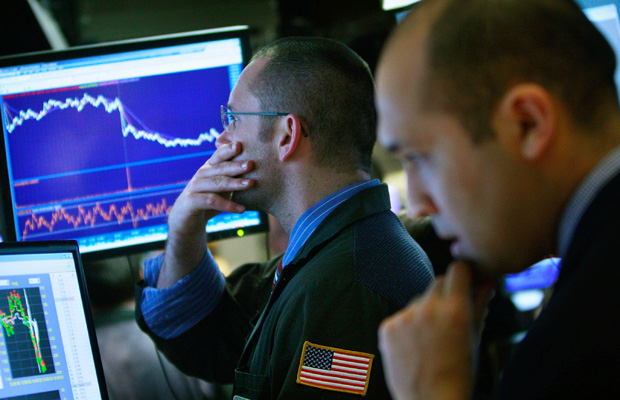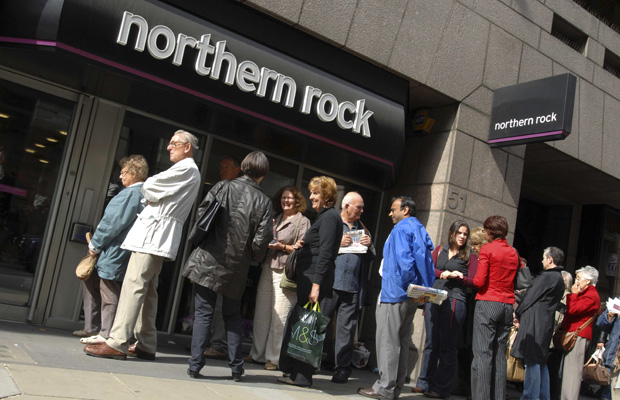Brink of collapse – how the global financial crisis began

Ten years ago today, French bank BNP Paribas announced the market had lost confidence with two of its hedge funds – effectively rendering them insolvent.
At the time, it didn’t seem that important. But it turned out to be the starting gun to the global financial crisis.
The two BNP funds had been stuffed full of US sub-prime mortgage debt.
For a decade, sub-prime debt had swept through financial markets, gaining in popularity. Millions of mortgages had been bundled into complex new structures called CDOs – Collateralised Debt Obligations – and sold to investors.
Bankers sitting in New York, Frankfurt and London helped pump these CDOs across global markets. And for a while it seemed like the world was awash with money.
With this backdrop, bank bosses lost sight of numbers and reason and started to chase growth and deals at the cost of everything else.
Later, Paul Volcker – the former US treasury Secretary – said history’s only useful financial innovation had been the ATM. Everything else, he claimed, turned out to be toxic.
Sub-prime debt certainly seemed to fit the Volcker bill.
Back then, I was a newspaper reporter covering mergers and acquisitions. I had spent the last few years writing about the frenzy of deals that saw much of the FTSE and British high street being bought and sold.
In August that year, however, the deals dried up.
I remember writing about HBoS’s disastrous loan to buy David Lloyd gyms. The deal, worth £940m, was overpriced. But up until then banks would lend to billionaires and private equity firms and then sell the debt on to voracious pension funds or hedge funds looking for a slice of the action.
In that era, the central premise seemed to be that, whether company debt, mortgages, or property, asset prices would always increase in value. Therefore, buying into debt, however risky, was always profitable.
But HBoS could not sell the David Lloyd loan – not even a penny of it.
Crunch time
It was the last big M&A deal in Europe for a long time and it heralded what was initially described as the credit crunch.
In the square mile, people thought it was just a liquidity issue. They wanted central bankers to step in and boost money flows, so that deal making could resume as normal.
But back then, Federal Reserve Chairman Ben Bernanke was confident that despite the increasing number of mortgage defaults “no serious harm would be done to the US economy”.
Looking back, it’s hard to believe how dismissive and reckless regulators and bankers were. Lord McFall, who used to run the Treasury Select Committee said those at the top of RBS and HBoS had been asleep at the wheel. That was probably true of journalists too.
What followed was a financial crisis that was on a par with the depression of the 1930s. In Europe, countries like Greece teetered on the edge of bankruptcy, as debt moved from banks to sovereign states.
In Britain, financial services – the most productive part of the UK economy – was decimated and dismantled, with scandal after scandal exposing rampant greed and rule breaking.
The banks in this country have still not recovered and the taxpayer is still under water with its investment in RBS.
Productivity in the economy has never quite bounced back. And while jobs returned, earnings never did.
New credit crunch?
In the place of sub-prime mortgages there are now dangerous levels of toxic auto-loans brewing up a new credit crunch.
Last year, a record £31bn of loans were taken out in the UK through car leasing – an incredible 90 per cent of all car sales.
Despite the trillions of pounds that were pumped into the financial system – levels of leverage around the world remain dangerously high.
And while regulation has sought to ensure no bank is too big to fail – we also mustn’t forget the bigger lessons of the financial crisis, just 10 years after the world skated so close to the edge.

Countdown to Crisis
July 2007: Goldman creates ABACUS – a package of subprime CDO debt it sold to investors knowing there were issues with the portfolio including hedge funds making big bets that it would go bust.
ABN Amro is one of the biggest investors. When RBS bought the bank, it was forced to pay Goldman $840m for the ABACUS losses.
But hedge fund manager Paulson, made about $1 billion by shorting ABACUS through Goldman. The bank picked up $15m in fees.
August 2007: HBOS’ Peter Cummings helps buy David Lloyd gyms for £940m but can’t syndicate the debt.
BNP Paribas tells investors two of its funds are basically insolvent because of a “complete evaporation of liquidity” in the market
September 2007: The Federal Reserve declares: “It is not the responsibility of the Federal Reserve – nor would it be appropriate – to protect lenders and investors from the consequences of their financial decisions.”
14 September: News leaks that Northern Rock has asked the Bank of England for help. The next day there is a £1bn run on the bank – the first British bank run in 150 years
October 2007: Fred Goodwin pushes ahead with a deal to buy ABN Amro. It’s the largest acquisition in banking history, worth £50bn.
January 2008: “The Federal Reserve is not currently forecasting a recession.”
January 2008: Analysts announce the largest single-year drop in US home sales in a quarter of a century
February 2008: Northern Rock is nationalised after deals to sell it to rivals fail
March 2007: The FED says mortgages to prime borrowers continue to perform well, with low rates of delinquency.
April 2008: RBS announces £12bn rights issue. Some of the hedge funds backing the deal pull out at last minute because they no longer trust the RBS numbers.
August 2008: Rumours circulate that US bank Lehman Brothers is looking for a buyer, with private equity firm KKR and Barclays linked to the deal.
Just 4 months after its rights issue, RBS announces its first loss in 40 years. In 2006, it was making £6.5bn of profits.
15 September 2008: Lehman Brothers files for bankruptcy, prompting worldwide financial panic. This is the moment the penny finally drops that the global system, that most people’s mortgages, loans and livelihoods are linked to, is very close to collapse.
17 September 2008: The UK’s largest mortgage lenders, HBOS, is rescued by Lloyds, but the £12bn deal ultimately proves worthless.
October 2008: Iceland’s three biggest commercial banks – Glitnir, Kaupthing, and Landsbanki – collapse. To protect British depositors, Gordon Brown uses anti-terror legislation to freeze the UK based assets.
8 October 2008: eight central banks including the Bank of England, the ECB and the Fed, cut their interest in a coordinated attempt to ease the pressure on borrowers.
13 October 2008: To avert the collapse of the UK banking sector, the Government buys stakes in RBS, Lloyds TSB, and HBOS worth £37bn. It also extends £200bn of liquidity to help them operate.
At the time, RBS’s balance sheet was bigger than the entire UK GDP – at £2.3 trillion.
By February 2009, another £13bn had been injected into RBS by taxpayers.
14 November 2008: The G20 meets for the first time since Lehman’s went under, in a meeting that was compared in significance to the Bretton Woods summit in 1944
April 2009: G20 agrees on a global stimulus package worth $5tn
